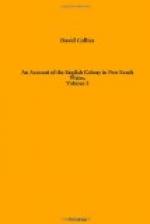The observations which were made by Mr. Flinders on the set of the current at different parts of the coast, being directly opposite to the remarks of Captain Cook, it may be proper to state them. That great and able seaman says, in his notice of the current on this coast, that ’It always ran with more force in shore than in the offing.’ Now, in going to the northward the sloop was kept as near in shore as circumstances would permit; but the whole sum of southing produced in eight entire days, from latitude 33 degrees 45 minutes to 24 degrees 22 minutes south, was sixty-five miles, almost the whole of which were lost off the Three Brothers and Smoky Cape, when their distance from the shore was more than in general it used to be. To counteract this, they had twenty-five miles of northing, reducing the current to thirty miles in eight days, which could scarcely be called a current.
On the other hand, their average distance from the shore, when on their return, was about twelve leagues, or barely within sight of the land; and in running the same difference of latitude in twelve days the sum of the southing was two hundred and eleven miles, and the northing but one mile and a half. Out of this, thirty-four miles were gained in one day when their distance off the shore was the greatest, being between twenty and twenty-five leagues.
From these data it should appear, that the current was strongest at the distance of five, and from thence to twenty or more leagues; and within that, there was some set to the northward. But Mr. Flinders thought it most probable, that the southerly current would prevail nearer to such projecting points of land as Point Danger, Smoky Cape, Red Point, and the Heads of Jervis Bay; perhaps close to them, at such times when its strength was greatest, for in that respect it had been found to vary much: it was even believed at Port Jackson, that the current changes its direction totally during some short space of time.
Of the tides it was scarcely necessary to say any thing; for, by a comparison of the times of high water at Bustard Bay-and at Port Jackson, it should seem that the flood came from the southward; and would therefore produce little or no set along the coast either way, in the greatest part of that space. It was probable, however that, to the southward of Smoky Cape, the flood would draw somewhat from the northward; for there the land trended to the westward of south; and likewise the nearer the coast lies east and west, the more set would be produced by the tide along it; as from Cape Howe to Wilson’s Promontory for instance. Again, from Break Sea Spit, the coast trends to the westward of north, which has a tendency to draw the flood from the SE and this was shown by Captain Cook to be the case.
We must here take leave of Captain Flinders, whose skill in exploring unknown coasts and harbours, so amply manifested in this excursion, creates an additional interest in the success of his present undertaking.




